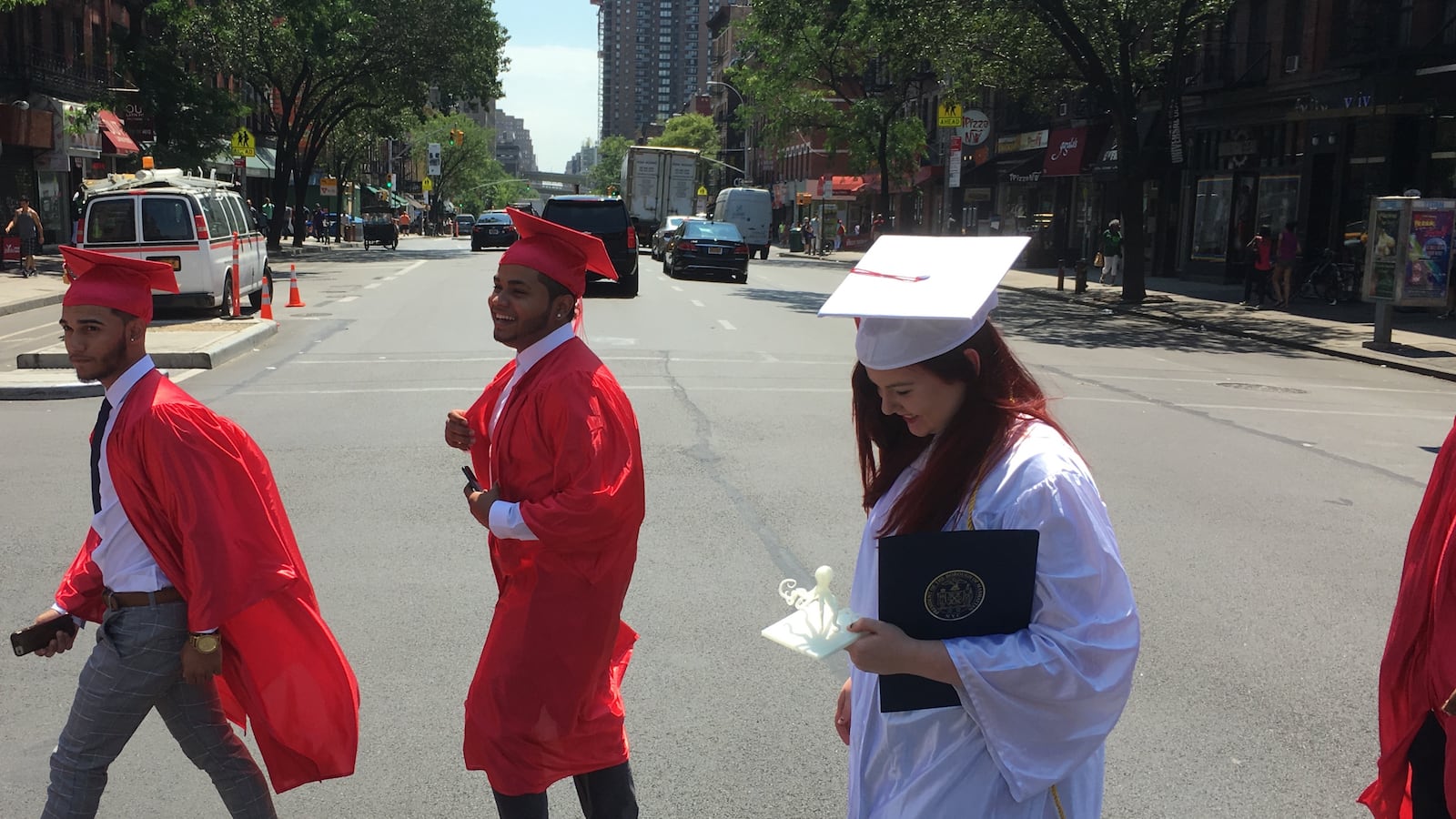When the state revealed last week that New York City’s graduation rate ticked up to nearly 76 percent, city officials argued it was yet another piece of evidence that their education agenda is bearing fruit.
But that increase coincides with a similar uptick in the number of students taking advantage of new graduation pathways, according to a Chalkbeat analysis of city data, complicating the narrative that rising graduation rates are necessarily pure evidence of gains in student learning.
Two state policy changes made in recent years are having an outsized effect: It is now possible to graduate with a lower score on Regents exams, five tests that students must typically pass to earn a diploma. And state officials have also allowed students to substitute one of the five Regents exams with a growing number of alternative tests, an option known as 4+1. (Overall, 9.2 percent of city students used one of those two methods to graduate in 2018, with slightly more than half opting for appealing low scores.)
Neither of those changes took effect for the first time last year, but students increasingly used them to graduate in 2018. The city’s gradation rate last year rose 1.7 percentage points — and 1.2 of that can be solely accounted for by a rise in students taking advantage of these two changes in graduation requirements.
“Roughly two-thirds of the increase in graduation rate can be attributed to the increased use of the 4+1 or the appeal option,” said Aaron Pallas, a professor at Columbia’s Teachers College who reviewed Chalkbeat’s analysis. “It’s not clearly due to an increase in student performance.”
Still, that conclusion comes with important caveats. Some students who used the 4+1 pathway may have been able to graduate if they had taken a fifth Regents exam. Plus, officials and advocates say many of the alternative assessments that can be switched for a fifth Regents exam are just as rigorous; in New York City, about three-quarters of students who replaced a fifth exam used a math or science assessment. (But another 14 percent of students who took advantage of 4+1 used an exam that evaluates basic work-entry skills.)
During a press conference, Mayor Bill de Blasio acknowledged those new graduation pathways, but said the broader pattern of rising graduation rates over the past 15 years suggests students are learning more.
“I think it transcends the various adjustments that have been made at the state level,” de Blasio said. “It indicates something much bigger that’s happening.”
Offering students new graduation options is part of a larger effort among state officials to balance New York’s graduation requirements — among the toughest in the country — with the reality that some students won’t be able to meet them. Research has generally found that high school exit exams do not increase student achievement but that they do increase dropout rates among vulnerable student groups.
Over the past seven years, state officials have made at least 15 changes to graduation standards, including tweaks designed to benefit students with disabilities and those who are learning English.
One recent change allowed students with disabilities to graduate while passing only two Regents exams, or none at all, as long as a superintendent signs off — a move that many special education advocates saw as a win that would allow students to demonstrate their learning and earn the benefits of a diploma even if they couldn’t pass the exams. (State officials said 66 city students with disabilities graduated that way in 2018, a tiny share of graduates.)
The two most consequential shifts, however, have been the expanded use of the alternative tests to replace a fifth Regents (4.3 percent of graduates last year) and expanding the range of low Regents scores that students can appeal (now used by 4.8 percent of city grads). In 2016, officials lowered the score students could appeal and also dropped an attendance requirement.
While the new pathways are allowing more students to graduate, they also have potential downsides. If educators know that standards are lower for certain student groups, it could create incentives to push those students into less demanding classes.
“Greater use of multiple pathways and increased college and career readiness can absolutely go hand-in-hand, and we see indications of that in the data” said Ian Rosenblum, the executive director of Education Trust-New York, a group that has closely tracked changing graduation standards. “At the same time, with the new pathways comes the responsibility to ensure that historically underserved students are not being tracked into less rigorous coursework and lower graduation standards.”
Danielle Filson, a city education department spokeswoman, emphasized that rising graduation rates will help students earn “a ticket to a better life.” Though officials acknowledged that the increase comes after changing graduation standards, they argued that gains on other measures also paint a positive portrait of the school system’s performance.
“This progress is not happening in a vacuum,” Filson added, pointing to decreasing dropout rates and increasing enrollment in college. She also noted the state’s overall graduation rate would not have increased last year if the city’s students were excluded.
But graduation rates are not necessarily good proxies for other measures of student learning, including test scores. Although more city students are earning diplomas, the city’s results on a major national assessment have been flat in recent years.
Sean Corcoran, a professor at Vanderbilt University who has conducted research on New York City schools and reviewed the graduation data at Chalkbeat’s request, noted there are lots of outside factors that can exert influence on graduation rates, including the student demographics of a given graduating class. He said it is important to track longer-term outcomes to assess the full impact of the policy changes.
“There is a lot of research out there that exit exams can be an obstacle for students,” Corcoran said. But “it’s a fine line between watering down standards and providing meaningful pathways for students.”

